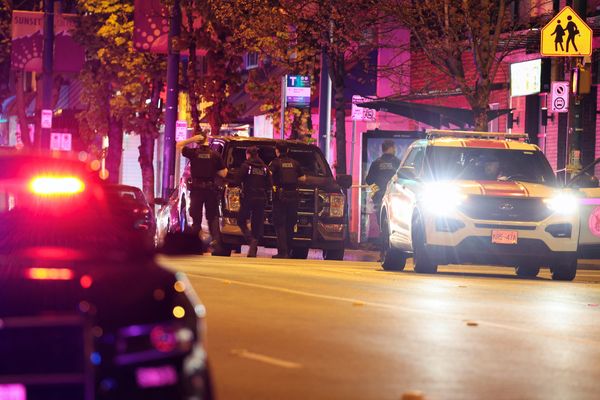
Fish Island, Tower Hamlets
(Picture: Fred Haworth)Cutting-edge residential developments in London and the capital’s commuter belt dominated the catalogue of winners at tonight’s Housing Design Awards 2022.
Fourteen housing schemes were named as the best in the country with seven based in London and the home counties including a 584-home complex in Lambeth on top of hidden nuclear tunnels which linked Parliament to M16 and Britain’s largest Passivhaus scheme in Camden.
These new places promote healthy lifestyles, foster community spirit and support family life while attempting to tackle both the housing shortage and the energy bills crises, according to the panel of judges who whittled the winners down from 100 entries.
The overall national winner was revealed to be Kampus in Manchester City centre, the repurposing of Victorian warehousing into loft-style apartments set in a green oasis.
A net zero scheme in York and a community-led housing project where all the homes are affordable in Newcastle were also both listed among the finalists.
The Housing Design Awards has been running for 72 years. The current panel of judges is 21-strong and includes Amy Burbridge, head of master development and design for Homes England and David Birkbeck the chief executive of the organisation Design for Homes.
“In the 1960s the UK built 400,000 homes a year. It’s slumped at best to 60 per cent of that because local authorities, which own tired estates where they struggle to house ever longer waiting lists, were stopped from redeveloping them,” says Birkbeck.
“Recent reforms opened the door and now councils are building places where both homeowners and renters want to live and that are so well insulated that residents are able to forget the cost of energy crisis.”
H&P takes a tour of the best housing developments on your doorstep in London and the south-east commuter belt.
Agar Grove, Camden
By Mae Architects and Hawkins Brown for Camden Council

Agar Grove was widely considered to a failed post-war housing estate, outdated with dead ends and dominated by gangs. The £97 million overhaul is based on a masterplan of traditional streets and squares with all front doors at ground level, better connecting the neighbourhood to Camden. It sits between Camden Road tube station and Caledonian Park. The brick and stone buildings will house 493 affordable (including discounted rent and shared ownership) homes for new and existing tenants all built to a Passivhaus standard, meaning they are highly insulated and energy efficient, reusing heat gathered from sunlight and household appliances. Such structures and fabrics can lead to a 90pc reduction in heating bills for residents.
Beaulieu Keep, Chelmsford
By Tate Hindle for Countryside Zest

The royal inventory of 1547 lists 29 bedrooms and four “bathing rooms” in what was Henry VIII’s Beaulieu Palace, three miles outside of Chelmsford in Essex. It is now part of a masterplan of 3,600 homes, a new school (for pupils aged two to 18) and a forthcoming station.
Beaulieu Keep is a collection of 321 sandy-coloured homes designed to hark back to traditional Essex farmsteads and barns in the ground of the Tudor palace. Built for families with bridleways and linear parks running through the homes and alongside them to promote cycling and walking.
Carlton Dene, Westminster
By Levitt Bernstein for Westminster City Council

This £35 million scheme, just north of the Paddington recreational ground, is designed for over 55s with additional care and provision for dementia. There are 65 extra care properties and 22 general care next to the Grade I listed St Augustine Church. The development is set out with easy wayfinding and visual connections to the shared and open spaces. The extra care homes have flexible partitions so that layout can be reconfigured based on need and to enable the residents to age in their homes. There are shared communal balconies overlooking the courtyards and with roof terraces for additional outside space. The homes are built to Passivhaus or low energy standards.
Fish Island, Tower Hamlets
By Haworth Tompkins for Peabody and Hill

Fish Island is a new area that sits on a 50-acre triangular slice of Hackney Wick between the Queen Elizabeth Park and the River Lea on its easterly border, Hertford Canal to the north with the A12 running alongside it to the west. The mixed-use scheme comprises 500 affordable housing units for residents to buy and studio space to house the creative community in former industrial buildings. 200m of canal frontage has also been opened up for public use.
Keybridge, Lambeth
By Allies and Morrison for Mount Anvil

On the site on an old telecomms exchange near the Vauxhall gyratory is a new micro neighbourhood of 584 homes across traditional looking red brick mansion blocks and contemporary towers. This mix of height and low rise enables density and for a third of the site to be open space. Underneath the scheme sits a hidden nuclear bunker thought to link to secret tunnels used by spies during the Second World War and connecting Whitehall with the M16 building. The 37-storey apartment block will rise above the bunker which is to be converted into a creative hub.
Lavender Hill, Wandsworth
By Sergison Bates Architects for Marston Properties

Nine new two-storey homes have been carved out of an abandoned brownfield site squeezed between existing houses close to Clapham Junction. The site was once home to a factory that processed metal sheets and is now a modern mews, densely planted around a communal courtyard. The properties have their own terraces and courtyard gardens to give residents extra light and air and the brickwork facades are a nod to the bygone Victorian industrial age.
Riverside Road, Watford
By Bell Phillips Architects for Watford Borough Council

Watford Borough Council has been spending £1 million a year on paying private landlords to house homeless families. This council-led project has created five new three-bedroom Passivhaus-standard homes for those who find themselves and children temporarily destitute. The properties have air source heat pumps, solar panels and are insulated to modern standards, they are also well connected to schools and public transport.







